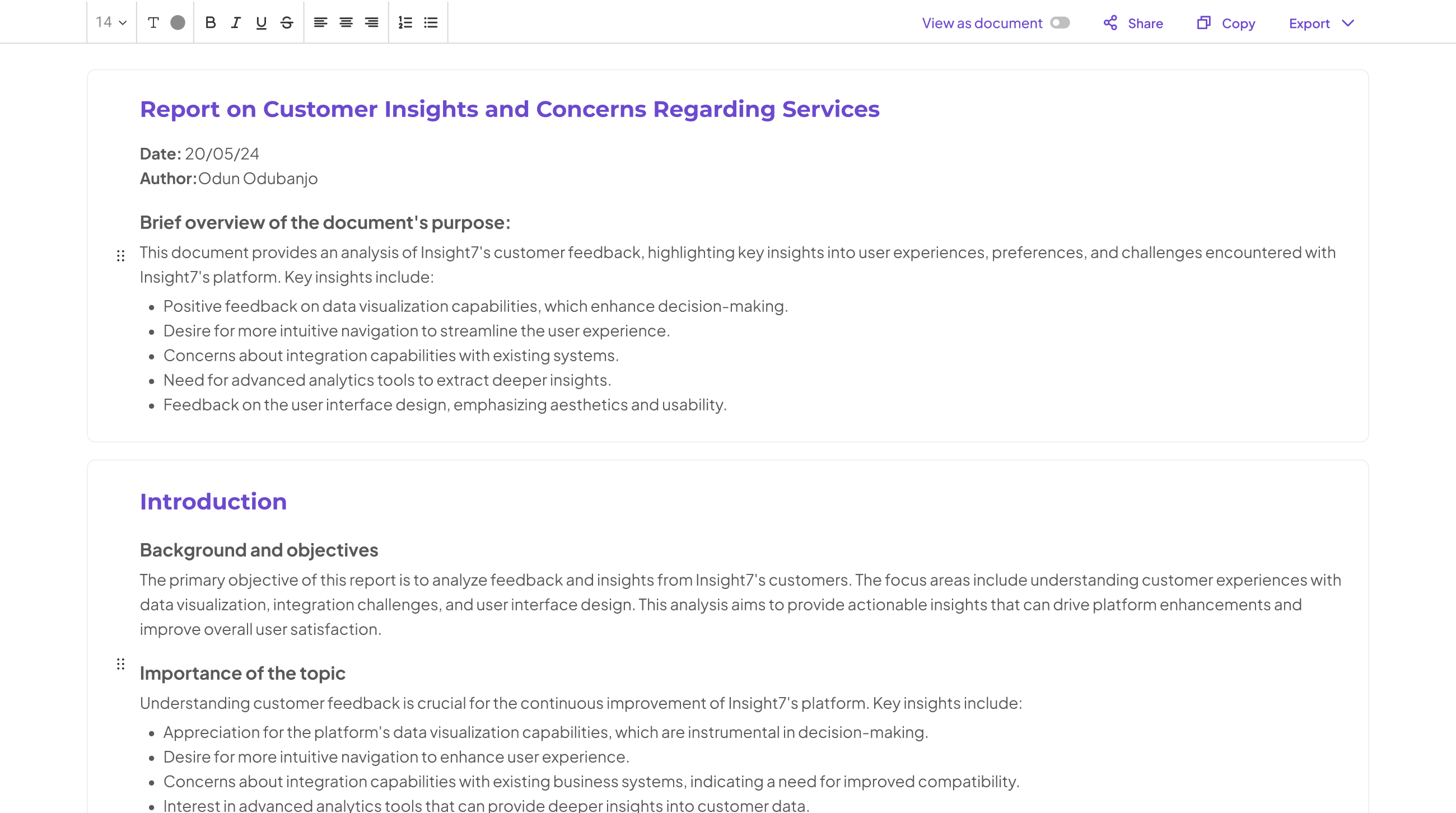How to visualize scorecards from exit interviews
-
Bella Williams
- 10 min read
Exit Interview Visualization serves as a crucial tool in understanding employee feedback at the conclusion of their tenure. These visual representations transform raw data into meaningful insights that can significantly enhance organizational processes. By effectively visualizing exit interview scores, stakeholders can identify patterns, trends, and areas for improvement, enabling data-driven decision-making.
This introduction emphasizes the importance of making exit interview data accessible and comprehensible. Organizations can transform quotes, sentiment, and themes from exit interviews into compelling scorecards that highlight key metrics. Ultimately, this visualization process not only clarifies employee sentiments but also fosters an environment of continuous improvement and engagement.
Transcribe & extract insights from interviews. At Scale.

Understanding Exit Interview Scorecards
Understanding exit interview scorecards involves examining how data from these interviews can be quantitatively evaluated. The scorecard serves as a summary of key performance indicators that highlight the strengths and weaknesses observed during exit interviews. This structured format helps organizations visualize trends, identify common issues, and ultimately improve their workplace environment. By reviewing individual case scores against set criteria, you gain insights into employee experiences and perceptions.
Effective visualization of exit interview scorecards requires a focus on several elements: clarity, consistency, and engagement. First, presenting the data in an easy-to-read format allows for swift comprehension of the insights. Consistent use of metrics across different scorecards ensures that comparisons can be accurately made. Lastly, engaging visual elements—like graphs and charts—attract attention and facilitate discussion. By visualizing these scorecards effectively, stakeholders can derive actionable strategies that enhance retention and employee satisfaction.
The Importance of Exit Interview Visualization
Exit Interview Visualization plays a crucial role in understanding employee experiences and perceptions within an organization. By transforming qualitative feedback into visual formats, organizations can easily identify trends, themes, and potential areas for improvement. This process cultivates a deeper understanding of the factors influencing employee retention and satisfaction.
Visualization enables decision-makers to quickly grasp complex data, allowing them to make informed choices about workforce management. For instance, graphs and charts can highlight recurring themes in feedback or showcase changes in employee sentiment over time. This clarity helps stakeholders to prioritize issues that require attention, ultimately shaping efforts to enhance organizational culture and employee engagement.
In summary, Exit Interview Visualization is vital for translating qualitative insights into actionable data. Engaging with visualized data ensures that organizations can maintain a healthy workplace, fostering a positive culture that resonates with current and future employees.
Key Metrics to Highlight
When visualizing scorecards from exit interviews, certain key metrics stand out as particularly valuable. These metrics provide essential insights into employee satisfaction, retention challenges, and overall company culture. By emphasizing these critical data points, organizations can better understand the factors influencing employee decisions to leave and tailor their strategies accordingly.
To effectively visualize exit interview data, focus on the following critical metrics:
- Employee Satisfaction Ratings: Understanding satisfaction levels helps pinpoint areas needing improvement.
- Reasons for Leaving: Categorizing departure reasons reveals trends that managers can address proactively.
- Length of Employment: Analyzing tenure helps identify patterns and distinguishes between seasoned employees and newer ones.
- Responses to Organizational Support: Evaluating feedback on support received during employment can show areas for further development.
- Future Recommendations: Collecting suggestions for organizational improvements can set actionable goals.
By tracking these metrics closely, organizations can enhance their understanding of employee dynamics and implement effective retention strategies through exit interview visualization.
Tools for Exit Interview Visualization
Effective Exit Interview Visualization relies on the right tools to interpret and present data clearly. A variety of software options are available, each offering unique features that can enhance the visualization process. Some tools allow for real-time data analysis, enabling you to identify both positive and negative feedback efficiently. This immediate feedback loop can support more informed decision-making for future improvements.
In addition to basic data visualization software, consider platforms that specialize in customer insights and sentiment analysis. These tools can provide in-depth correlations between different datasets, allowing you to draw meaningful conclusions. Advanced AI capabilities enable users to query extensive datasets to uncover underlying trends and patterns. Furthermore, visualizations can include comparative analyses, such as feedback from different locations, to identify geographical differences in customer experiences. Employing these tools effectively transforms exit interviews into powerful insights that can drive organizational change.
Generate Detailed Reports from Your Qualitative Data in Minutes.
insight7: Leading the Way in Visualization
Effective Exit Interview Visualization is essential for gaining actionable insights from employee feedback. Visual representation allows organizations to sift through complex data quickly and discern significant trends and patterns. A compelling visualization can highlight both positive and negative comments, enabling decision-makers to understand employee sentiments and identify areas for improvement.
To lead the way in this visualization journey, consider the following approaches. First, categorize feedback into themes to reveal critical insights. Next, employ different graph types, such as bar charts or heat maps, to display quantitative metrics clearly. Understanding regional variations in feedback can guide localized interventions. Finally, utilize data querying tools to compare datasets meaningfully, such as evaluating responses from different departments or locations. By employing these strategies, organizations can transform exit interview data into a comprehensive visualization that fosters informed decision-making and drives positive change.
Additional Tools for Effective Visualization
To enhance your visualization efforts, it is crucial to invest in tools that streamline and enrich the Exit Interview Visualization process. Various software options can help transform raw data into engaging visuals, making insights more accessible and actionable. For example, graphical platforms can create charts or graphs that highlight trends in employee sentiment, showcasing both positive and negative feedback effectively.
Another option is interactive dashboards, which allow users to explore data in real-time. These tools enable stakeholders to filter and dive deeper into specifics, ensuring they grasp the nuances behind each scorecard. Integrating tools that utilize artificial intelligence can further elevate the process by identifying patterns that may not be immediately evident. Employing these advanced methodologies can lead to a more thorough understanding of the exit interview data, ultimately guiding better organizational decisions.
Step-by-Step Guide to Creating Exit Interview Visualizations
Creating exit interview visualizations is a crucial process for deriving insights from employee feedback. This guide will walk you through essential steps to turn raw exit interview data into meaningful visual representations. Beginning with data collection and organization, ensure that all feedback is categorized, which allows for easier analysis. This foundational step is vital as it frames the quality of your visualizations.
Next, selecting the right type of visualization is key. Different formats such as bar graphs, pie charts, or word clouds can serve various purposes. Opt for the one that best communicates the insights you want to highlight. Finally, implementing visualization tools effectively brings your data to life. Several tools are available to aid in creating dynamic visualizations, transforming your exit interview scorecards into compelling visuals. By following these steps, you can successfully present findings that foster accountability and drive meaningful change.
Step 1: Data Collection and Organization
Collecting and organizing data is the foundation of effective exit interview visualization. Begin by compiling all relevant data from exit interviews, focusing on key insights captured in transcripts and scorecards. Group the data based on categories, such as pain points, recommendations, and employee sentiment. This process not only streamlines data but also enhances clarity, making it easier to identify trends. When data is organized methodically, it can reveal patterns that inform decision-making.
Next, consider using tools that facilitate data analysis. As you categorize the insights, create a project for each time frame—monthly or quarterly—allowing for deeper analysis. Summarize the findings to highlight themes, such as common pain points or recurring suggestions from employees. This organized approach not only aids in visualizing the data but also provides actionable insights that can drive improvements within the organization. Ultimately, effective data collection and organization pave the way for impactful exit interview visualization.
Step 2: Choosing the Right Visualization Type
When addressing the topic of exit interview visualization, selecting the appropriate type of visualization is a crucial step. This phase helps uncover insights in a visually compelling manner, making it easier for stakeholders to understand complex data. For instance, charts can effectively display trends over time, while bar graphs are excellent for comparing different metrics, such as reasons for employee departures.
Visualizations such as pie charts may be useful for illustrating the demographics of respondents, showcasing the percentage of employees that left for various reasons. It's essential to match the visualization type with the message you aim to convey. Tailoring each graph or chart to highlight specific exit interview insights leads to a more engaging and informative presentation. Ultimately, effectively choosing the right visualization type enhances communication and boosts decision-making processes regarding employee retention and organizational improvements.
Step 3: Implementing Visualization Tools
Implementing visualization tools is a crucial step in transforming exit interview data into actionable insights. First, it's important to select the right software or platforms that allow you to create visually compelling scorecards. Look for tools that offer features like data integration, customizable templates, and various graphing options. This flexibility will enable you to present the feedback in an engaging manner, capturing both qualitative and quantitative insights effectively.
Next, consider how different visualization types convey information. Bar charts could highlight trends in employee satisfaction, while word clouds may illustrate recurring themes in open-ended comments. Be open to experimenting with various formats to determine which resonates best with your audience. Utilizing these exit interview visualization methods will not only enhance understanding but also facilitate more informed decision-making in future organizational strategies.
Conclusion: The Benefits of Exit Interview Visualization
Visualizing exit interview data offers numerous advantages that enhance organizational understanding and decision-making. Through exit interview visualization, businesses can easily identify trends, both positive and negative, within employee feedback. This clarity helps foster a deeper comprehension of employee experiences, enabling leadership to address areas needing improvement effectively.
Moreover, visual representations of exit interviews promote transparency in the analysis process. Stakeholders can grasp insights quickly, which aids in strategizing future initiatives. By focusing on visualized scorecards, companies can translate raw feedback into actionable goals, paving the way for more informed choices and a better workplace culture overall.







